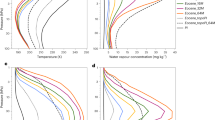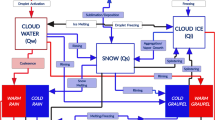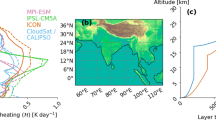Abstract
Chemical reactions on polar stratospheric cloud (PSC) particles are responsible for the production of reactive chlorine species (chlorine ‘activation’) which cause ozone destruction1. Gas-phase deactivation of these chlorine species can take several weeks in the Arctic winter stratosphere, so that ozone destruction can be sustained even in air parcels that encounter PSCs only intermittently2,3. Chlorine activation during a PSC encounter proceeds much faster at low temperatures when cloud particle surface area and heterogeneous reaction rates are higher4. Although mountain-induced atmospheric gravity waves are known to cause local reductions in stratospheric temperature of as much as 10–15 K (5-9), and are often associated with mesoscale PSCs10,11,12, their effect on chlorine activation and ozone depletion has not been considered. Here we describe aircraft observations of mountain-wave-induced mesoscale PSCs in which temperatures were 12 K lower than expected synoptically. Model calculations show that despite their localized nature, these PSCs can cause almost complete conversion of inactive chlorine species to ozone-destroying forms in air flowing through the clouds. Using a global mountain-wave model8, we identify regions where mountain waves can develop, and show that they can cause frequent chlorine activation of air in the Arctic stratosphere. Such mesoscale processes offer a possible explanation for the underprediction of reactive chlorine concentrations and ozone depletion rates calculated by three-dimensional models of the Arctic stratosphere13,14,15,16,17.
This is a preview of subscription content, access via your institution
Access options
Subscribe to this journal
Receive 51 print issues and online access
$199.00 per year
only $3.90 per issue
Buy this article
- Purchase on Springer Link
- Instant access to full article PDF
Prices may be subject to local taxes which are calculated during checkout



Similar content being viewed by others
References
Scientific Assessment of Ozone Depletion: 1994(Rep. No. 37, World Meteorological Organisation, Geneva, (1994)).
Jones, R. L., McKenna, D. S., Poole, L. R. & Solomon, S. On the influence of polar stratospheric cloud formation on chemical composition during the 1988/89 Arctic winter. Geophys. Res. Lett. 17, 545–548 (1990).
McKenna, D. S. et al. Calculations of ozone destruction during the 1988/89 Arctic winter. Geophys. Res. Lett. 17, 553–556 (1990).
Borrmann, S. et al. Heterogeneous reactions on stratospheric background aerosols, volcanic sulfuric acid droplets, and type I polar stratospheric clouds. J. Geophys. Res. 102, 3639–3648 (1997).
Gary, B. L. Observational results using the microwave temperature profiler during the Airborne Antarctic Ozone Experiment. J. Geophys. Res. 94, 11223–11231 (1989).
Volkert, H. & Intes, D. Orographically forced stratospheric waves over northern Scandinavia. Geophys. Res. Lett. 19, 1205–1208 (1992).
Leutbecher, M. & Volkert, H. Stratospheric temperature anomalies and mountain waves: A three dimensional simulation using a multi-scale weather prediction model. Geophys. Res. Lett. 23, 3329–3332 (1996).
Bacmeister, J. T., Newman, P. A., Gary, B. L. & Chan, K. R. An algorithm for forecasting mountain wave-related turbulence in the stratosphere. Weath. Forecst. 9, 241–253 (1994).
Dörnbrack, A., Leutbecher, M., Volkert, H. & Wirth, M. Mesoscale forecasts of stratospheric mountain waves. Meteorol. Applic.(in the press).
Stanford, J. L. & Davis, J. S. Acentury of stratospheric cloud reports: 1870–1972. Bull. Am. Meteorol. Soc. 55, 213–219 (1974).
Peter, Th., Müller, R., Drdla, K., Petzoldt, K. & Reimer, E. Amicrophysical box model for EASOE: Preliminary results for the January/February 1990 PSC event over Kiruna. Ber. Bunsenges. Phys. Chem. 96, 362–367 (1992).
Carslaw, K. S. et al. Particle microphysics and chemistry in remotely observed mountain polar stratospheric clouds. J. Geophys. Res.(in the press).
Lutman, E. R. et al. Three-dimensional studies of the 1991/92 northern hemisphere winter using domain-filling trajectories with chemistry. J. Geophys. Res. 102, 1479–1488 (1997).
Bell, W. et al. Measurements of stratospheric chlorine monoxide (ClO) from ground-based FTIR observations. J. Atmos. Chem. 24, 285–297 (1996).
Douglass, A. et al. Athree-dimensional simulation of the early winter distribution of reactive chlorine in the north polar vortex. Geophys. Res. Lett. 20, 1271–1274 (1993).
Goutail, F. et al. in Polar Stratospheric Ozone(eds Pyle, J. A., Harris, N. P. & Amanatidis, G. T.) 574–579 (Air Pollution Res. Rep. No. 56, European Communities, Brussels, (1996)).
Hansen, G., Svenøe, period, Chipperfield, M. P., Dahlback, A. & Hoppe, U.-P. Evidence of substantial ozone depletion in winter 1995/96 over northern Norway. Geophys. Res. Lett. 24, 799–802 (1997).
Carslaw, K. S., Peter, Th. & Clegg, S. L. Modeling the composition of liquid stratospheric aerosols. Revs. Geophys. 35, 125–154 (1997).
Knudsen, B. M. Accuracy of Arctic stratospheric temperature analyses and the implications for the prediction of polar stratospheric clouds. Geophys. Res. Lett. 23, 3747–3750 (1996).
Mishchenko, M. I. Light scattering by randomly oriented axially symmetric particles. J. Opt. Soc. Am. 8, 871–882 (1991).
DeMore, W. et al. Chemical Kinetics and Photochemical Data for Use in Stratospheric Modeling(Publ. 97-4, Jet Propulsion Lab., Pasadena, (1997)).
Edouard, S., Legras, B., Lefevre, F. & Eymard, R. The effect of small-scale inhomogeneities on ozone depletion in the Arctic. Nature 384, 444–447 (1996).
Wu, D. L. & Waters, J. W. Gravity-wave-scale temperature fluctuations seen by the UARS MLS. Geophys. Res. Lett. 23, 3289–3292 (1996).
Wu, D. L. & Waters, J. W. Satellite observations of atmospheric variances — a possible indication of gravity waves. Geophys. Res. Lett. 24, 3631–3634 (1996).
Meilinger, S. K. et al. Size-dependent stratospheric droplet composition in lee wave temperature fluctuations and their potential role in PSC freezing. Geophys. Res. Lett. 22, 3031–3034 (1995).
Müller, R. et al. Chlorine chemistry and the potential for ozone depletion in the Arctic stratosphere in the winter 1991/92. Geophys. Res. Lett. 21, 1427–1430 (1994).
Carslaw, K. S., Peter, Th. & Müller, R. Uncertainties in reactive uptake coefficients for solid stratospheric particles — 2. Effect on ozone depletion. Geophys. Res. Lett. 24, 1747–1750 (1997).
Acknowledgements
We thank M. Mishchenko for help with the T-matrix calculations. Part of this work was funded by the European Communities, the German BMBF, the Office of Naval Research (ONR) and NASA's Atmospheric Chemistry Modeling and Analysis Program (ACMAP).
Author information
Authors and Affiliations
Corresponding author
Rights and permissions
About this article
Cite this article
Carslaw, K., Wirth, M., Tsias, A. et al. Increased stratospheric ozone depletion due to mountain-induced atmospheric waves. Nature 391, 675–678 (1998). https://doi.org/10.1038/35589
Received:
Accepted:
Issue Date:
DOI: https://doi.org/10.1038/35589
Comments
By submitting a comment you agree to abide by our Terms and Community Guidelines. If you find something abusive or that does not comply with our terms or guidelines please flag it as inappropriate.



